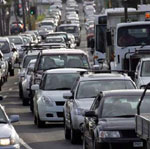Melbourne Mayor calls for bold ideas
to manage the city’s transport system
2 March 2006: In an editorial article to explain the thinking behind the City of Melbourne’s recently published draft Transport Strategy, Lord Mayor John So writes that far from being anti-car, Melbourne had been car friendly and the city was committed to welcoming people by all means of transport. However, the Mayor makes it clear that Melbourne’s existing road system was reaching saturation. “Road congestion is costing our city about $2.7 billion a year, now. If nothing is done, by 2015 this congestion could cost around $6 billion annually,” he writes.
Facing transport reality
By John So, Lord Mayor of Melbourne
In February 2006, the City of Melbourne released its draft Transport Strategy which discusses the issues and lists the actions the Council should take to face the challenge of welcoming more people coming to the city.
The Strategy’s development has been guided by a transport industry reference group, which includes the Committee for Melbourne, the Port of Melbourne, VicRoads, transport operators (freight, public transport and taxi industry), resident groups, the RACV (Royal Automobile Club of Victoria) and Public Transport Users Association. It is also informed by advice from transport academics and submissions from the general public.
Far from anti-car, Melbourne has been car friendly and the city is committed to welcoming people by all means of transport. Melbourne ranks in the top four cities internationally for car spaces with 33 spaces per 100 employees in the CBD (Central Business District). By comparison, New York has six spaces per 100 people while Sydney has 22. Indeed, the Strategy calls for lower short term parking prices to encourage people to visit the city by car off peak, and affordable short term car parking has always been one of my priorities.
The other reality we cannot ignore is that our city is growing. In the last four years, City of Melbourne residents have grown from 50,000 to 69,000 and CBD residents have grown from 8,300 to 13,300. Between 1992 and 2002, inner city residents have grown by 830 per cent, from 1008 people to 9375.
There are more people coming to the city. At present around 645,000 people visit the CBD everyday and current projections show that within a decade this figure will grow to more than a million people.
Growth is, of course, a good problem to have but research from the Committee for Melbourne, Business Council of Australia and others shows our existing road system is reaching saturation. Road congestion is costing our city about $2.7 billion a year, now. If nothing is done, by 2015 this congestion could cost around $6 billion annually.
In simple terms, road congestion means that we pay more for what we buy and take longer to travel around our city – it wastes our time and our money.
There is also an environmental cost to traffic. Pollution threatens our quality of life and Melbourne’s liveability, of which we are all so proud. I have always held that one cannot expect people to give up one form of transport, such as private cars, without providing suitable, convenient alternatives.
I believe that the short and immediate solution to these problems is for improvements in the public transport system as well as our bicycling and pedestrian networks in order to provide tangible and real choices for people coming to the city to live, to work, to shop and to enjoy.
With the $5 million we get from the State Government’s parking levy, we are putting it all toward improving the accessibility for people coming to the city. We are improving bicycle routes, widening footpaths and starting a 12-month trial of a free tourist shuttle bus to take visitors to our attractions. This investment is necessary to create better transport choices for Melburnians.
I am also calling for free shuttle trams running up and down St Kilda Road, along Swanston Street to Melbourne University, and shunting of suburban trams running along the route. I am currently working with our major stakeholders on the feasibility of this and how it could be funded. Ultimately, I would like to see free shuttle trams in the city and shunting of all tram services at the fringes.
In the big picture, we also need to invest in our road and freight services so that we can address the growth in our metropolis. The State Government forecasts an extra million people by 2030.
For a continuing healthy, happy and prosperous community, I urge the State Government to take these issues on board and commit significantly to transport initiatives in April’s Liveability Statement.
The bigger picture calls for bold ideas and there have been a number of excellent suggestions for how we might sustain our liveability by improving our transport system. To uphold our growth and prosperity into the future, I call for the government to start planning to complete the missing links before the city of Melbourne is choked to death – an East/West rail and road tunnel link (along the Eastern freeway) and a north/south rail and road tunnel link (under Punt Road) needs to be on the agenda.
Fundamentally, we have to accept our growth forecasts by providing immediate improvements to the public transport system as well as our bicycling and pedestrian networks in order to provide real choice for people.





























